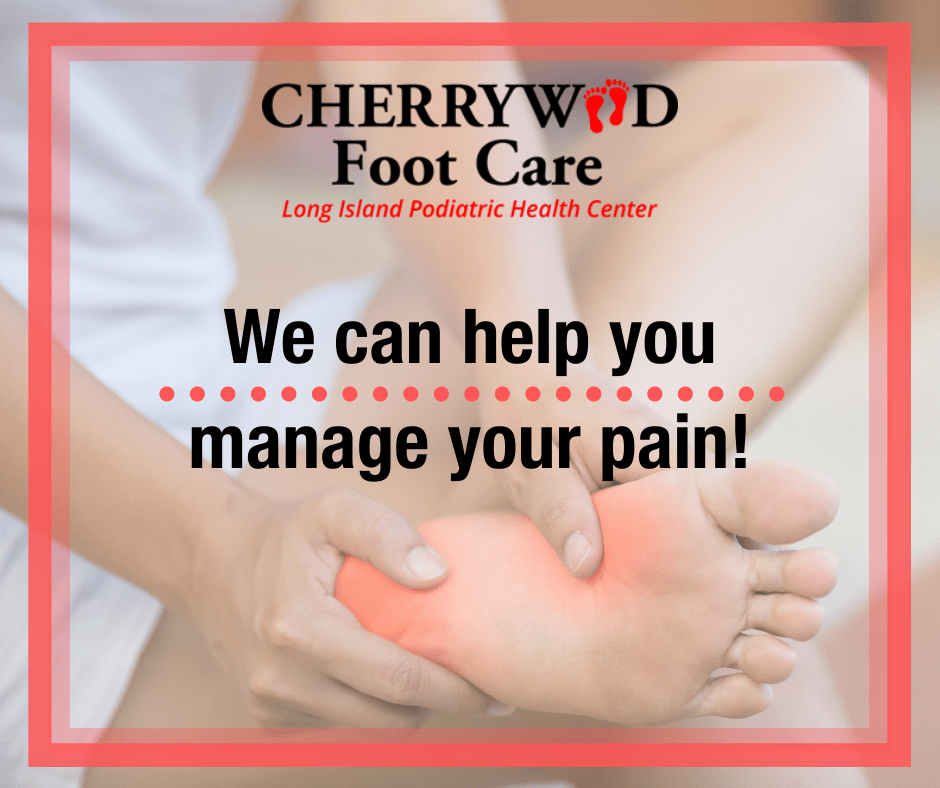Podiatrist on Long Island That Accepts Healthfirst
Dr. Joseph Burke and his team at Cherrywood Foot Care serving the communities of Bellmore, North Bellmore, Merrick, Wantagh, and East Meadow utilizes the latest cutting-edge podiatric technologies, from digital radiology, and Noveon laser technology for toenail fungus treatment, to shock wave therapy for heel pain and the minimally invasive surgical procedure, endoscopic plantar fasciotomy. Dr. Burke specializes in the biomechanics of the foot, including custom orthotics and surgical correction of foot deformities. Contact us for a qualified and trusted Podiatrist on Long Island That Accepts Healthfirst.

Diabetes and Foot Health
Diabetes is known to cause vascular and nerve damage, leaving diabetics more susceptible to foot problems. Of the many problems diabetics may face, peripheral neuropathy and peripheral vascular disease are two major conditions that cause diabetics to have problems with their feet. Take note of all the following conditions, causes, and symptoms of diabetic foot problems in order to give yourself the best chance to get the help you need.
Peripheral vascular disease
Peripheral vascular disease is known as an illness inside the blood vessels that resides near the heart and brain. This condition yields foot problems because it blocks off the supply of blood that is high in oxygen, to reach vital organs, feet, legs, and other parts of the body. The symptoms of this disease are far more than simple foot cramps. The symptoms for this disease include:
- Cold feet
- Lack of laceration healing on the feet and legs
- Painful toe ulcers
- Feet color fluctuated from pale to deep red
- Thickening toenails
- Loss of hair on the foot surface
- Foot numbness
Peripheral Neuropathy
Peripheral Neuropathy, often referred to as having “glove and stocking” symptoms, is a condition that attacks the nerves of the spinal cord and brain. Symptoms of this condition are directly linked to hand and feet problems which is where the saying “glove and stocking” symptoms originated. If you have diabetes and are feeling any of the following symptoms, contact your Podiatrist on Long Island that accepts Healthfirst at Cherrywood Foot Care:
- Itching of the feet and hands
- Burning of the feet and hands
- The intense pain of the feet and hands
- Numbness of the feet and hands
- Tingling sensation located in the feet and hands
Of the feet, the toes will usually feel the most severe end of these symptoms. Be on the lookout for these to approach the problem quickly!
Other Common Diabetic Foot Problems
Diabetes brings on a multitude of problems with the feet. More than 15% of people with diabetes also endure foot agony. The long list of problems, that can be treated and prevented with a Podiatrist on Long Island that accepts Healthfirst, are as follows:
- Foot distortions: Ingrown toenails, bunions, spurs in the heel, and “hammertoes”
- Toe problems: Fungus of the toenail and burning sensation causing difficulty in sleeping
- Skin problems: Dry skin, skin cracks, skin cuts, irritation/itching of the skin, and foot ulcers.
Again, these problems are chronic and cause diabetics a great deal of pain so
becoming aware of these conditions is a step in the right direction. Be sure to check your feet daily and be self-conscious of the feelings in your feet and toes. Also, be sure your shoes are the perfect fit so you do not have to worry about your shoes causing you extra pain.
Cherrywood Foot Care
Our Podiatrist on Long Island that accepts Healthfirst will give you the best chance to manage and recover from your foot problems caused by diabetes. Our team of trained professionals will not only put their knowledge to work but they will also utilize industry-leading technology to ensure your condition is handled professionally. We specialize in diabetic foot problems and realize it is a big problem for people, that is why we draw up a custom plan to execute each problem. To trust us in getting you back on your feet with confidence, just call (516) 826-9000.
Home Remedies for Ingrown Toenail
Have you been experiencing swelling, redness, and pain on either side of your toe, on or near your toenail? If you are dealing with these issues, you might have an ingrown toenail. Ingrown toenails occur when your toenail, typically on your big toe, grows into and cuts the surrounding skin or tissue. If you are looking for a Podiatrist on Long Island that accepts Healthfirst, reach out to Cherrywood Foot Care. Our team uses cutting-edge podiatric technologies and procedures to help all of our patients!
Depending on how severe your ingrown toenail condition has developed, home remedies may prove to be enough to cure your ailment. Cherrywood Foot Care providesPodiatrist on Long Island that accepts Healthfirst, and we can diagnose and provide you with the correct treatment needed. Below are a few home remedies you can try:
- Soak the affected area in warm water with Epsom salts and castile soap several times a day for 15-20 minutes. This will help relieve pain and can reduce the chances of a future infection.
- Carefully peel back the skin away from the ingrown nail, and place a small piece of cotton between your nail and skin. Replace the cotton as needed after every soak.
- Use an antibiotic cream on the affected toenail and cover it with a bandage.
- Wear shoes that have enough space for your toes, and wear sandals rather than shoes to limit any pressure on the affected toe.
If the above home remedies for ingrown toenails fail to provide any relief, call our staff and inquire about scheduling an appointment forPodiatrist on Long Island that accepts Healthfirst.
Podiatrist Treatment for Ingrown Toenail
Podiatrists have a few treatments for ingrown toenails which are relatively painless and have very few complications associated with them. Your podiatrist will help determine the right treatment option for you, depending on the severity of your ingrown toenail and any infection that may have developed. After most treatments, you likely will not have any restrictions on bathing, activities, or shoe wear. Some ingrown toenail treatments include:
- Raising the nail and inserting a splint under the ingrown toenail – This helps the nail grow over the skin and prevents it from growing further into the toe. This treatment is used more often for lesser ingrown toenails.
- Remove the ingrown portion of the toenail – This procedure is used for more severe ingrown toenails. A light anesthetic will be used to numb your toe for this procedure.
- Remove the ingrown portion of the toenail and treating the nail root – The treated nail root that is causing the ingrown nail will not grow back after being treated. This only affects the corner responsible for the ingrown nail. This procedure is used for ingrown toenails that recur on the same toe.
An untreated ingrown toenail can become infected and spread the infection, causing major complications for your foot health. We don’t advise you to ignore ingrown toenails and seek help if home remedies can not provide relief. If you are looking for a Podiatrist on Long Island that accepts Healthfirst, Cherrywood Foot Care urges you to contact us and make an appointment today!

